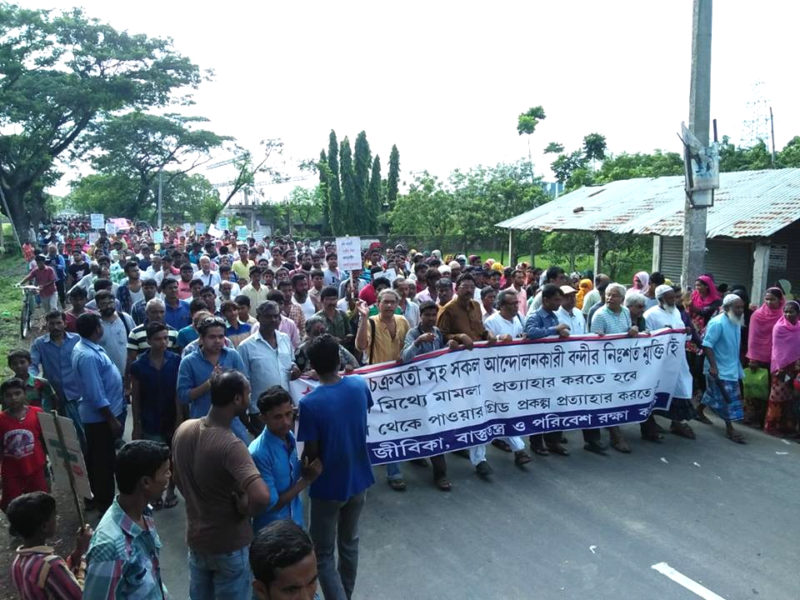Last Saturday on 11th August, “Land Livelihood Ecology and Environment Protection Committee” (henceforth ‘Land Committee’), spearheading the villagers’ resistance to an electrical transmission sub-station being built in Bhangor by the Power Grid Corporation of India Ltd (PGCIL), at South 24 Pargana district of West Bengal, signed an agreement with the West Bengal Government, marking a conclusion of sorts, to the 2-year long anti-Power Grid resistance movement. Fifty representatives from 20 villages connected with the struggle were present as the ‘agreement’ got signed. The State Government was represented by the South 24 Parganas District Magistrate Y. Ratnakar Rao, police officials including the SP and the CI. Also present were PGCIL and WBSEDCL officers. The agreement broke the 18 month deadlock in Bhangor, calling for an end to the protests in exchange for significant reduction in the scale of the project, and an economic package amounting to Rs 12 crore. A GroundXero report.
How exactly did the signing of the treaty come about?
Thousands of villagers connected with the struggle against the Bhangor Power Grid had been demanding unconditional dialogue with the state government for a long time. Last year, on 17th January, police and ruling party goons opened fire on a protest demonstration of 30 to 40 thousand peoples on the Haroa Road, killing two villagers – Mofizul and Alamgir. This flagged the beginning of the Government’s iron fist policy when it came to dealing with the struggle. Since then, villagers and their supporters have been regularly implicated on false charges including UAPA. Nearly 70 people have been put in the jails over the last year and a half. The police, together with TMC leader Arabul Islam’s armed gangs actively supported by the administration, literally turned people’s lives into hell on a daily basis. Relentless terror and economic blockade were imposed on the villages. The villagers put up an unyielding fight against all of this, under the leadership of the Land Committee. The movement attained a new dimension during this year’s Panchayat elections. Despite extreme repression by the ruling party, thanks to a High Court order allowing Land Committee candidates from the Polerhat-II area to file their nominations through WhatsApp, the Committee could contest from 8 seats, winning 5 of them by huge margins. Quite visibly, after this the Government started shifting it’s stance vis-a-vis the struggle, including initiating back-channel talks with committee leaders and abandoning the earlier position of brutal repression.
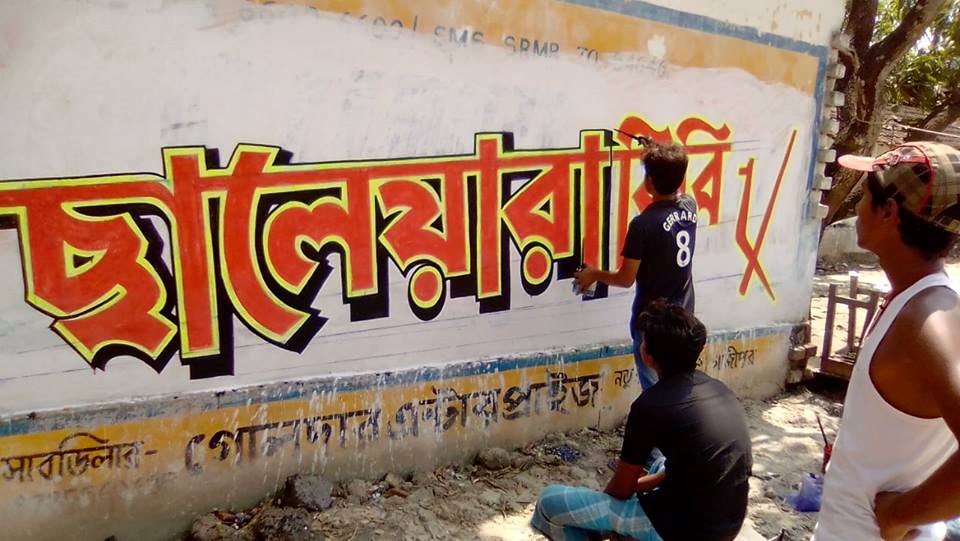
Graffiti for Land Committee candidates contesting Panchayat elections in Bhangor
The major breakthrough was achieved when state intelligence and police were able to arrest Alik Chakraborty from Bhubaneshwar, on 31st May. Alik had gone there to receive urgent medical treatment. He was subsequently booked under several non-bailable cases including murder charges and the draconian UAPA.
According to sources, while Alik was assured the best of medical treatment, he was also offered the proposal of ending the deadlock through senior police and administrative officials who met him while he was undergoing treatment, and put forward the government’s proposal for negotiations. While under police custody at Bhangor police station Alik was allowed to hold a meeting with his most trusted lieutenants – Mirza Hasan, Ali Mohammed, Sajarul Islam and Mosaraf Hossain. The Government while opening doors to negotiation also made its intentions clear that it would pursue firmly with the legal cases if the Land Committee remains stubborn in its resistance to the power grid.
It is at this point that the ice seems to have melted. Feelers were sent from the prison for negotiations and the Government sat down with the Land Committee for a dialogue for the first time, on 23rd June. Although initially the Government stuck to its earlier stand that “outsider leadership” won’t be allowed to participate in the dialogues but subsequently it backed out from that position. Sensing positive mood among the committee members, the government initiated move to release Alik Chakraborty from prison and accelerate the negotiation process. The public prosecutor didn’t oppose his bail plea and on 16th July Alik was released on bail to give final shape to the agreement. The PGCIL representatives informed that they are backing down from the original proposal of setting up of 16 high voltage electricity lines across Bhangor. Instead, they asked for the villagers’ permission for two 400 kV lines for PGCIL, and two 220 kV lines for WBSEDCL (West Bengal State Electricity Distribution Company Limited) – so a total of 4 lines. The Committee asked for this proposal to be submitted in writing. The next meeting took place on 23rd July, where the Government submitted the written proposal, and also indicated it’s acceptance of the rest of the demands put forth by the Committee – withdrawal of false cases, compensation for land owners, compensation for all the families whose members got killed or injured, or incurred losses in any way during the course of the movement, and inclusive development of the region. The next meeting was held on 7th August. In this meeting the Government submitted a further detailed proposal towards withdrawal of cases, economic compensation and overall developmental plans. Eventually, on 11th August, an agreement was signed between the Land Committee and the Government representatives. Both sides agreed to abide by the terms of the agreement.The PGCIL representatives informed that they are backing down from the original proposal of setting up of 16 high voltage electricity lines across Bhangor. Instead, they asked for the villagers’ permission for two 400 kV lines for PGCIL, and two 220 kV lines for WBSEDCL (West Bengal State Electricity Distribution Company Limited) – so a total of 4 lines.
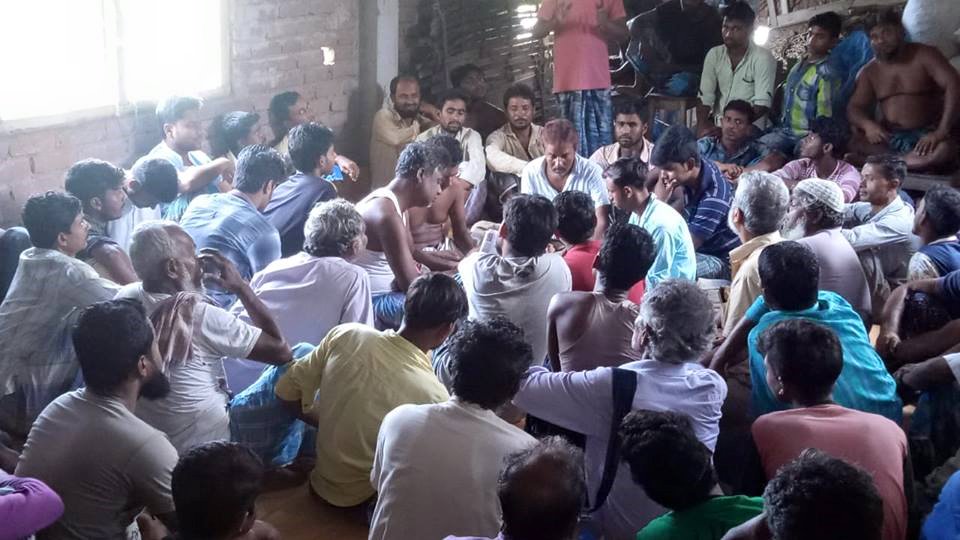
Land Committee Meeting at Bhangor post Alik Chakraborty’s arrest, to chart out future course of action. 1st June 2018.
Debates and controversy around signing of the Agreement
The “agreement phase” led to a vigorous debate within the Land Committee, the villagers and the activists who had extended solidarity to the movement. On one hand was the opinion that the proposal to merely cut down the number of the high voltage transmission lines from 16 to 4 does not alter the nature of the project and it implied accepting the Power Grid and so it should be rejected. The key logic behind this was:
a. Since the Land Committee led the struggle on the demand of scrapping the Power Grid altogether, not even a single high-voltage line should be accepted.
b. Even if only two 400 kV lines come up, it will affect the entire Khamarait village, and parts of Machhibhanga. These two villages have been the nerve center of the entire struggle. Therefore the Land Committee should reject the proposal.
The other opinion was to consider the proposal of cutting down the number of lines from 16 to 4, mainly because:At the outset, the initial opinion of ‘no power grid’ seemed to be dominant among the villagers. But when the leaders pointed out that sticking to this would effectively imply an end to the process of negotiations with the Government, and a restart of the police terror and oppression, pursuing of legal cases, the villagers started having second thoughts.
a. Most of the villages, other than Khamarait and Machhibhanga, would in this way be saved from the damage. In case the movement continues after rejecting this proposal, the participation of people from all these unaffected villages might wane in the days to come, leading to progressive weakening of the struggle. And in such a situation, if the state government along with the ruling party goes back to its earlier policy and resumes repression, it would then be hard to defend such an attack with a weakened base.
b. While it is true that Khamarait and Machibhanga villages will get affected, but the curb on the number of the transmission lines means an overall relief, though partial, from the damages that the Power Grid in its actual plan would have caused. In that case, “special compensation” could be demanded for Khamarait village.
c. The number ‘16’ was progressively reached at by the PGCIL, in accordance with the ERSS V, X and XVIII schemes, which are basically ‘open ended’ projects. This means in future the number of high voltage electrical transmission lines could very well go up from 16. Now on the other hand, because of the agreement, the number of lines stands limited to 4, in the times to come.
d. Under the current proposal, the Government has agreed to paying compensation to the families of persons killed during the agitation, those who were injured, and who have incurred other losses (such as destruction of homes, shops, etc.). The demand of withdrawing all criminal cases from those who were part of the struggle has also been accepted. Developmental demands such as construction of roads, upgrading of the hospital, cleaning up of Bidhyadhori river that flows nearby, improving the sanitation system, building of a cold storage, etc., have also been accepted. Hence, overall, the proposal deserves consideration and should be accepted.
These two sets of opinions started getting reflected in the Land Committee meetings following the Government’s proposal. At the outset, the initial opinion of ‘no power grid’ seemed to be dominant among the villagers. But when the leaders pointed out that sticking to this would effectively imply an end to the process of negotiations with the Government, and a restart of the police terror and oppression, pursuing of legal cases, the villagers started having second thoughts. With the local leadership of the land committee sharing similar views, the rebellion against the agreement among the villagers was contained and it gradually became meek. Eventually, on 10th August, the Extended General Council meeting of the Land Committee took unanimous decision in favour of signing of the agreement.
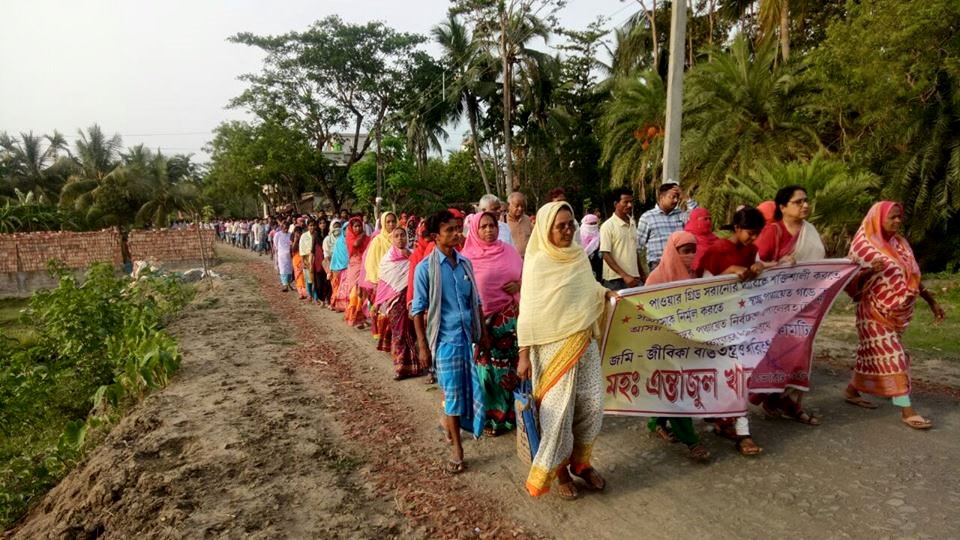
Protest rally against booth capturing by TMC, and killing of Hafizur Rahman Molla. 15th May 2018.
During this period, debates also started fomenting within the “Bhangor Sanhati Committee” (a coalition of several organisations and individuals, created to support the Bhangor struggle from outside), henceforth ‘Solidarity Committee’. A letter signed by 14 members of the Solidarity Committee alleged that “negotiations with the Government are going on without taking into consideration the overall public opinion of villagers in Bhangor”. Human Rights organisation APDR, a strong ally of the struggle, alleged in a statement that “large sections of the people of Bhangor are angry with the methods and position of the leadership (of the Land Committee)”. A press release from the Bhangor Solidarity Committee alleged that “The people of Bhangor have been tricked … the highest leadership of the (Land) Committee have surrendered (to the Government), betraying the villagers”. Notably, another political organisation that has been a central part of the struggle – the Mazdoor Kranti Parishad (MKP), whose members were also in the Land Committee – were absent on the day of signing of the agreement, though their representative attended all the negotiation meetings held till then. MKP didn’t issue any public statement till date as to why they backed out of the agreement at the last moment. However sources told GroundXero that they have strong reservations about the way the agreement was hurriedly pushed through by the highest leadership disregarding the dissenting villagers’ voices and solidarity activists’ opinions. The CPI(ML) Liberation and the CPI(M) who had extended active support to the movement and were a part of the solidarity network lamented the agreement as a unholy compromise and surrender to the government by the Red Star leadership. Political analysts however point out that their opposition to the agreement has more to do with closing of the anti-Mamata front than anything else.
The crux of the controversy lies in the interpretation and explanation by the Red Star leadership that the “4 lines proposal” means fundamental change in the character of the project. Alik Chakraborty announced that the government has backed down from establishing ‘power grid’ in Bhangor and instead only a ‘regional power sub-station will be built’. He proclaimed it as a victory of the ‘No Power Grid’ movement. This was strongly contested by the villagers and critics who pointed out that the leadership along with the government is playing semantics with the people. They alleged it’s a lie and trickery to say that there will be no ‘power grid’. The project continues as it was when construction of the sub-station in Bhangor was stalled in January 2017 by the people’s movement.The Government also accepted rest of the demands put forth by the Committee - withdrawal of false cases, compensation for land owners, compensation for all the families whose members got killed or injured, or incurred losses in any way during the course of the movement, and inclusive development of the region.
Going forward, a ‘non-partisan’ review of the struggle that must go on
Every mass movement deserves a minimal amount of time to ensure a factual and complete review of its self. Initial exuberance on one hand and instant dejection and rejection on the other – both tend to come in the way of an unbiased analysis of the situation. The reference frames of the judgment /analysis run the risk of being unfairly swayed by either over-optimism or cynicism.
Left forces can not avoid sincere discussion and debate regarding the role of the Party and its relationship to people’s movement. Part of the problem in this case seems to have risen from the leadership’s self belief in playing the role of the ‘vanguard’, keeping the Party in command, apparently even at the cost of a much greater democratic consolidation which seemed to be taking place around Bhangor. Left forces need to work out the dynamics of how intra-Party democratic process and agentative involvement of general masses can be ensured while taking crucial decisions in the course of a People’s movement.
The allegations that the highest leadership in this case have rushed the process of negotiations, and haven’t been “democratic enough” with the process pursued towards building a consensual opinion around signing of the agreement – cannot be out rightly rejected. When a significant number of voices raise similar objections or disapprovals – that too those who are not the enemies, but supporters of the struggle – such opinions must be treated with respect and care and not arrogantly rejected as romantic idealism of ‘city intellectuals and revolutionaries’. The leadership could have been more patient when it came to resolving some of these debates across different sections of society including the villagers themselves. They could have engaged in more sincere discussions with the outside solidarity forces – both organisations and individuals – who have stood firmly in support of the movement. It is also not true that such opportunities or scope did not exist.Left forces can not avoid sincere discussion and debate regarding the role of the Party and its relationship to people’s movement. It's necessary to work out the dynamics of how intra-Party democratic process and agentative involvement of general masses can be ensured while taking crucial decisions in the course of a People’s movement.
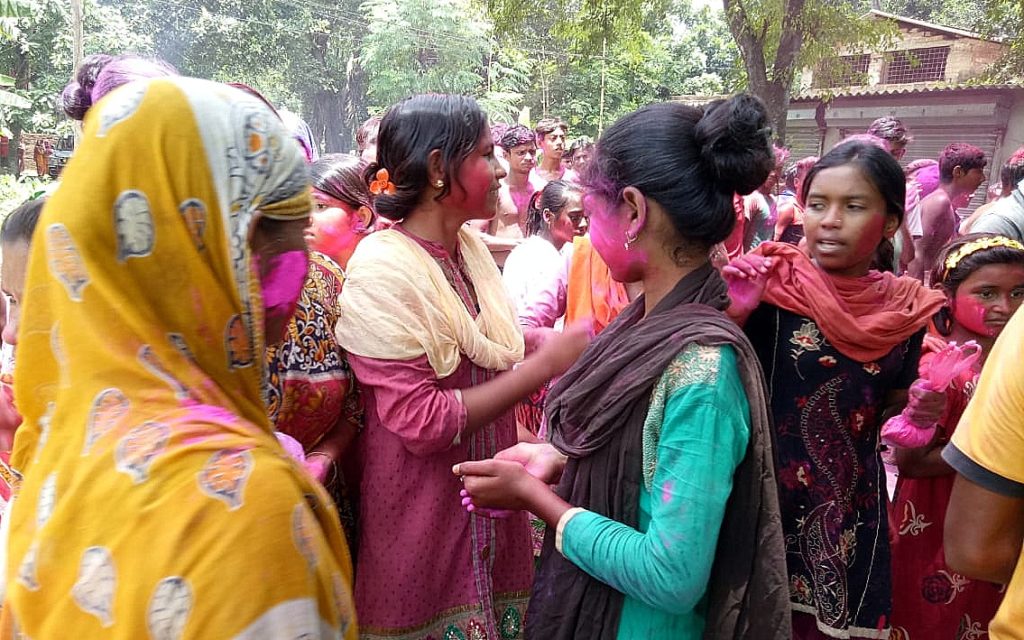
Celebrations in Bhangor over signing of the agreement
On the other hand, the Committee and its political leadership have claimed that they can’t be accused of being undemocratic in going about the entire process. They point to the fact that a number of meetings of the village level committees had been conducted from 9th July to 9th August, 3 extended General Council meetings have been held, and 2 General Body meetings have been organised. The 45 to 50 representatives that were present during the signing of the agreement, were duly elected representatives of their respective villages. On 10th August, the Extended General Council meeting passed the unanimous resolution permitting the leadership to agree to the terms of the agreement. The Council members are also all elected representatives from the villagers. The leadership argues that in case the general opinion across the villages was against signing of the agreement, one would assume that these representatives would have had to face public wrath when they got back to their villages. Not only that no such incident has reportedly occurred, in fact the day after the signing of the agreement, a few thousand villagers broke out into celebrations, set off fireworks, played with colours, and took out a victory rally from Bokdoba to Pagla Peer – a stretch of about 6 to 7 km.While a section of people are still skeptical and/or confused, it seems that a majority of the people of Bhangor have accepted the agreement. After two long years of unending struggle, daily violence and loss of blood and lives, they can now finally breathe in some kind of peace.
While a section of people are still skeptical and/or confused – not being able to gauge whether signing the agreement was the right decision to take -but it seems that a majority of the people of Bhangor have accepted the agreement, even if reluctantly. After two long years of unending struggle, daily violence and loss of blood and lives, they can now finally breathe in some kind of peace.
According to the latest reports, the families of the martyrs and those of the severely injured, have all accepted the Government’s monetary compensation of Rs. 8 lakh (each) and Rs. 2 to 4 lakh (each) respectively, without any notable objections. Construction work on the stalled sub-station has also started with no untoward incident being reported.
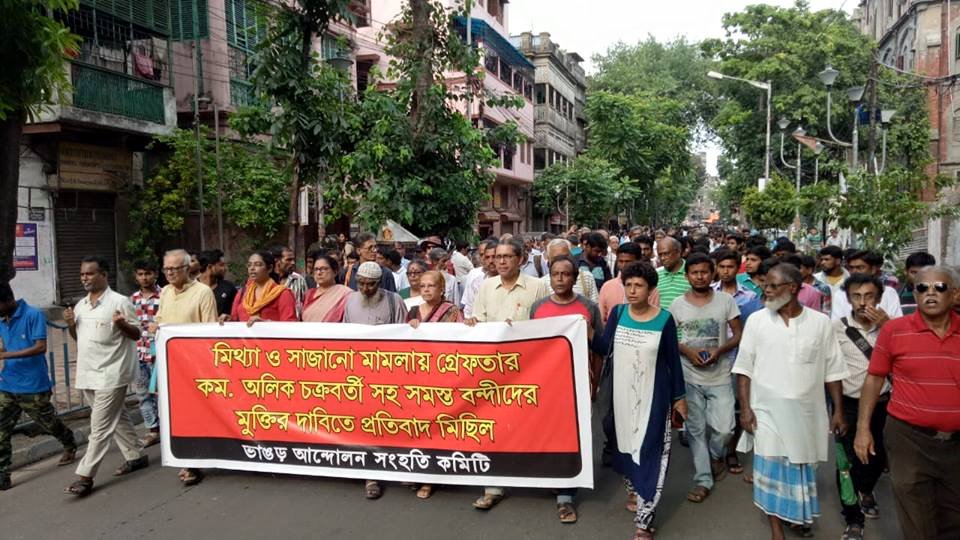
Rally in Kolkata taken out by the Bhangor Solidarity Committee, demanding immediate release of Alik Chakraborty and other Bhangor prisoners. 4th June 2018.
A few words in the end…
“We strongly believe that one episode in the movement has reached a completion, not the movement itself. The unity that was struck through this struggle, inside Bhangor and across West Bengal, must be kept alive. Such unity is essential for the implementation of the treaty. This unity is the primary antidote against the Governments’ and administrations’ age old tradition of signing and sabotaging such agreements”, said a press release by CPI(ML) Red Star.

Hafizur, killed during Land Committee’s Panchayat election campaign in front of cameras, allegedly by TMC leader Arabul Islam’s gang members.
The Bhangor movement, under the current regime of Trinamool Congress, has been significant on many counts. In these times when the ruling party has established uncontested stranglehold and hegemony over every corner of the state, the fact that thousands of people from more or less 20 villages (of Bhangor) have fought valiantly and relentlessly for the past couple of years against the Government, it’s police, its administration, and the ruling party’s armed gangs enjoying complete impunity – is historic in itself.
Under the Mamata regime, it’s becoming increasingly difficult to build and develop mass struggles. Democratic spaces are continuously shrinking across the society. This Government was able to destroy the leadership of the Lalgarh movement, and more recently, could create deep cracks in the leadership of the Gorkhaland movement. In the midst of all this, the Bhangor movement has been a glorious exception. Despite various ups and downs, the Land Committee leadership was able to retain it’s unity so far. They have been able to force the Government to the negotiating table and accept its many demands. The review process of the struggle must go on in a constructive way. However, in these times of darkness for people’s movements, the various positives from the struggle undeniably seem much more than a little!
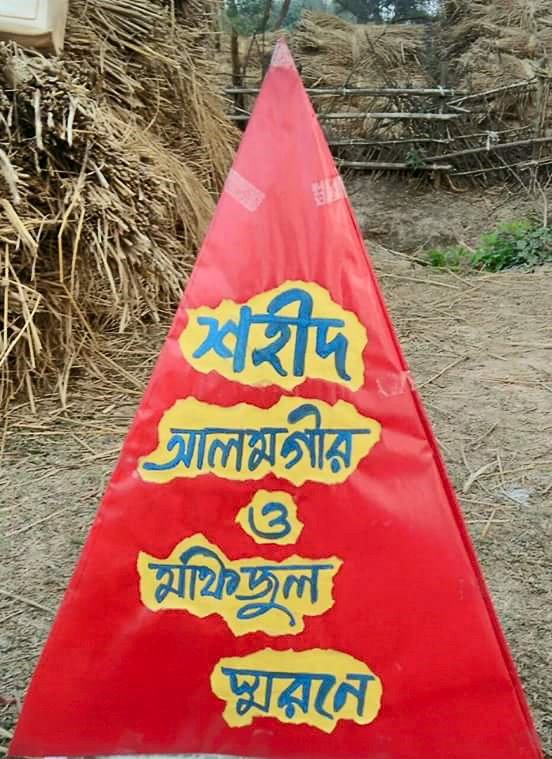
In memory of martyrs Alamgir and Mofizul. Bhangor.
All photos are courtesy the Land Livelihood Ecology and Environment Protection Committee.

